November 1998 – October 1999
Here are excerpts from the Minutes of the meetings of the Depleted Uranium Firing Environmental Review Committee which relate to the firings at at the Kirkcudbright Range, near Dundrennan, Dumfries and Galloway.
An introduction to these Minutes is here.
Acronyms:
KTA, Kirkcudbright Training Area, Ministry of Defence (MOD)
DERA, The Defence Evaluation and Research Agency, established in April 1991 as part of the MOD. In July 2001, DERA was split into two organisations:
QinetiQ, a privatised commercial company, and
DSTL, Defence Science and Technology Laboratory (MOD)
RO, Royal Ordnance
BNFL, British Nuclear Fuels Ltd.
EA, Environment Agency
SEPA, Scottish Environment Protection Agency
DTEO, Defence Test and Evaluation Organisation (MOD)
PLSD, Protection and Life Sciences Division (MOD)
CDA, Centre for Defence Analysis (MOD)
D SEF Pol, Directorate of Safety, Environmental and Fire Policy (MOD)
DG(Nuc), Director General (Nuclear) (MOD)
DUWG, Depleted Uranium Working Group (MOD)
The text below is quoted directly form the Minutes.
Minutes of the 17th Meeting of the Depleted Uranium Firing Environmental Review Committee (DUFERC) on 26 November 1998
There is a perceived problem of land contamination at Kirkcudbright and sampling results could suggest the migration of DU contamination around the Range; it is certainly true that sabots travel further than originally thought.
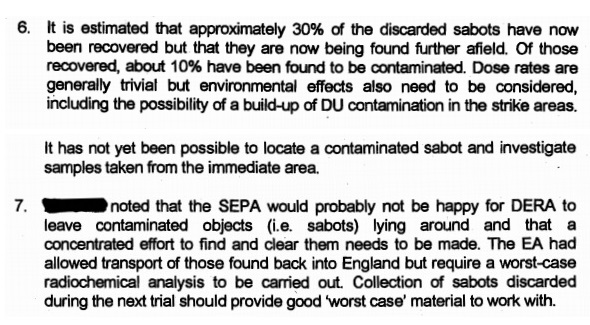
A programme of investigational work is to be presented to DERA Central for internal funding including the creation of both terrestrial and underwater DU ‘gardens’, with high priority given to investigations into the action of the material in these gardens and computer modelling of dispersion … It was intended to plant terrestrial DU gardens in appropriate locations at both Eskmeals and Kirkcudbright, plus an undersea garden offshore at Kirkcudbright. This would allow examination of complexing and migration of UO2 and comparison of the data with that from accelerated corrosion trials in the laboratory.
(Redacted name) notes that the SEPA would probably not be happy for DERA to leave contaminated objects (i.e. sabots) lying around and that a concentrated effort to find and clear them needs to be made. The EA had allowed transport of those found back to England but require a worst-case radiochemical analysis to be carried out. Collection of sabots discarded during the next trial should provide good ‘worst case’ material to work with.
It appears that livestock may be grazing contaminated areas. (Redacted name) reported that while this situation was not ideal, the animal indicators so far analysed indicate negligible intake of radioactive material.
A PR ‘script’ is required on the handling recovered DU.
Full text here.
Excerpts from Minutes of the 18th Meeting of the Depleted Uranium Firing Environmental Review Committee (DUFERC) on 4 March 1999
A substantial proportion of the discarded sabots from the Kirkcudbright Range have been found to be contaminated. A radiochemical analysis is needed to determine the precise levels of contamination. This could be carried out by BNFL Springfields (British Nuclear Fuels Limited), but there is difficulty in finding funding for this work, and for the collection and disposal of sabots. If SEPA takes an interest in the collections and disposal of sabots, it would present funding difficulties. It would be prudent to establish where responsibilities lay for this work.
Gypsy Point was now the favoured site for a bombing range, placing the target area further from the proposed DU garden.
The Gardens: The investigator (she) has now completed a literature review and identified terrestrial garden areas: Little Raeberry at Kirkcudbright and VJ at Eskmeals. Royal Ordnance has agreed to provide the DU rods which will be used for the experiments, and these will be ‘sliced’ by DERA Fort Halstead … The marine garden at Kirkcudbright was proving more difficult. She was having discussions with DERA Bincleaves and the University of Portsmouth for advice on setting up this facility. The use of boat-type mooring or buoyed heavy cage was most likely, but either will require the use of boat for access. The land Garden may be set up first, but the priority should be with investigations into the marine corrosion aspects.
Recovering fired projectiles is not a technical requirement of the CHARM project, and so no funding from the Royal Ordnance would be forthcoming for this work. Further, RO reports that restricting the flight of a projectile would be extremely difficult, and could render the projectile aerodynamically unstable.
There had been a DU fire at (Redacted location). There was some contamination within the workshop building although no DU had been detected outside. Some MPs had raised questions but not, as yet, as PQs.
The Press Office do not hold any form of ’defensive brief’ regarding possible enquiries about a recovered DU projectile.
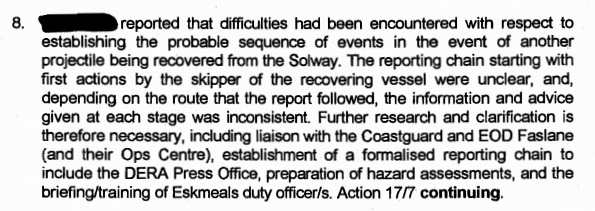
A plain, strong, lockable wooden box with a plastic bag and foam rubber padding inside has been manufactured as a container for the transport of recovered projectiles.
Full text here.
Excerpts from Minutes of the 19th Meeting of the Depleted Uranium Firing Environmental Review Committee (DUFERC) on 24 June 1999
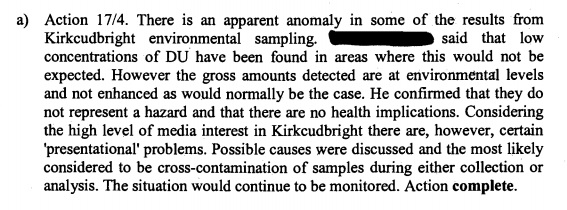
The Radiological Safety Assessment covering the potential dose to a member of staff recovering a DU penetrator discovered by a member of the public has been prepared.
The possibility of an over water recovery of a DU projectile had been investigated. There was no requirement from the customer for such an exercise and no finance available from within the Sector.
BNFL had suggested in the past that there was scope for DU to contain reactor cycle materials.
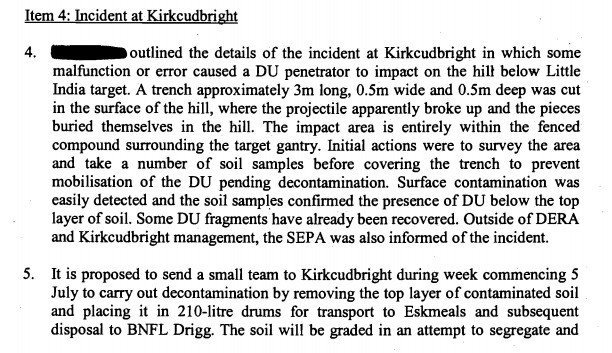
As to further excavations, the feeling is that it’s better to record where it is, but leave it for future recovery … How deep the material is in the soil is not known.
A defensive press brief was circulated regarding the possibility of a member of the public recovering a DU penetrator.
The marine garden at Kirkcudbright has not yet been established; divers are not available.
A visit by (Redacted name) to American DU facilities reports that they consider projectiles to have a 7-year life-span in soil, during which the corrosion products ‘expand’ to approximately 5 times the original volume of the projectile.
A letter had been received from the Dumfries and Galloway Council regarding the possibility of beryllium contamination. An investigation should happen.
Full text here.
Excerpts from the Minutes of the 20th meeting of the Depleted Uranium Firing Environmental Review Committee (DUFERC) on 19 October 1999
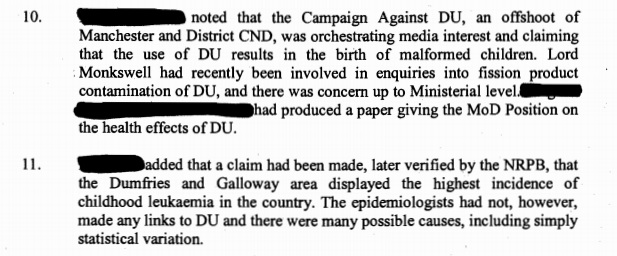
(Redacted name) reported that a number of additional firings were now required by the customer. Two were to be carried out in the following week, and the programme would continue into 2001 and possibly beyond. It was appropriate that [redacted word] should be aware of this.
(Redacted name) gave a short presentation covering recent activities at Kirkcudbright during which areas of contaminated land had been found, beyond that which had been anticipated. Following a general discussion, it was agreed that any contamination arising as a result of DERA’s activities would continue to be dealt with by DERA but that “historical” problems should be passed on to the appropriate owner, with appropriate advice.
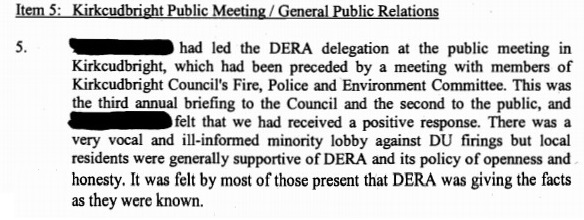
(Redacted name) had spoken with DG(Nuc) – the MoD Department responsible for the control of nuclear materials – and asked them to provide a statement regarding which organisation holds title to the DU fired on the ranges. No definitive statement was obtained. unfortunately no definitive statement was obtained, but it appears likely that the organisation holding the DU is responsible for it. Action complete.
(Redacted name) said that the risk of cross-contamination during the collection of environmental samples would always be present…but he was satisfied that the risk had been minimised as far as possible … UKAS accredited methods employed virtually rules out any possibility of cross contamination at this point.
(In the case of an unidentified object being found by a fisherman, the first point of contact) was not the Coastguard, as had been believed, but the local Harbourmaster. Standing instructions were that the object should be replaced into the sea and a description of the object and precise location logged. The EOD unit at Faslane would only respond to instructions from their Headquarters and not to a call from the Coastguard or Harbourmaster.
(The site at Kirkcudbright) had not been vested in DERA upon its formation in April 1995. DERA had managed the DU firing programme and attached health, safety and environmental issues arising since then. Contamination by recent malfunctions have been managed appropriately, but no action could be taken on ‘historical’ contamination.
The marine DU garden might be established at Luce Bay on a submerged concrete plinth previously used as the foundation for a target gantry.
Computer modelling of projectile entry into water had started. the tip of the projectile would erode and the projectile may deform. This did not correlate with data from the previous round of DU projectiles, Destiny.
(Redacted name) reported on a claim that had been made by a DERA photographer that he had been involved with early DU firings without the provision of protective clothing, dosimetry or information. This had been thoroughly investigate. It had been proved to the claimant’s entire satisfaction that he had been mistaken, and the claim had been withdrawn.
Full text here.


